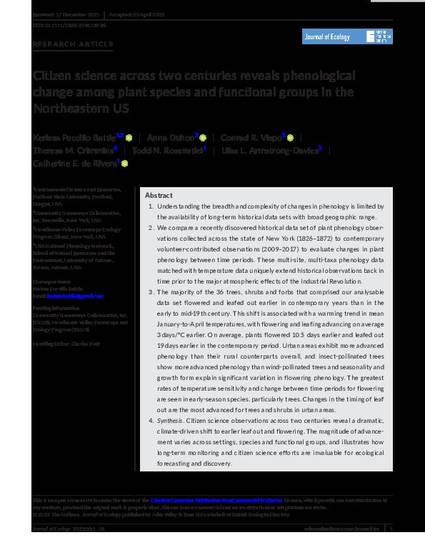
Article
Citizen Science across Two Centuries Reveals Phenological Change among Plant Species and Functional Groups in the Northeastern US
Journal of Ecology
Sponsor
This research was funded by the Community Greenways Collaborative, Inc (501c3) and the Hawthorne Valley Farmscape Ecology Program, of the Hawthorne Valley Association (501c3).
Document Type
Article
Publication Date
5-16-2022
Subjects
- Plants -- Genetic markers,
- Plants -- Evolution,
- Plant ecology
Disciplines
Abstract
- Understanding the breadth and complexity of changes in phenology is limited by the availability of long-term historical data sets with broad geographic range.
- We compare a recently discovered historical data set of plant phenology observations collected across the state of New York (1826–1872) to contemporary volunteer-contributed observations (2009–2017) to evaluate changes in plant phenology between time periods. These multi-site, multi-taxa phenology data matched with temperature data uniquely extend historical observations back in time prior to the major atmospheric effects of the Industrial Revolution.
- The majority of the 36 trees, shrubs and forbs that comprised our analysable data set flowered and leafed out earlier in contemporary years than in the early to mid-19th century. This shift is associated with a warming trend in mean January-to-April temperatures, with flowering and leafing advancing on average 3 days/°C earlier. On average, plants flowered 10.5 days earlier and leafed out 19 days earlier in the contemporary period. Urban areas exhibit more advanced phenology than their rural counterparts overall, and insect-pollinated trees show more advanced phenology than wind-pollinated trees and seasonality and growth form explain significant variation in flowering phenology. The greatest rates of temperature sensitivity and change between time periods for flowering are seen in early-season species, particularly trees. Changes in the timing of leaf out are the most advanced for trees and shrubs in urban areas.
- Synthesis. Citizen science observations across two centuries reveal a dramatic, climate-driven shift to earlier leaf out and flowering. The magnitude of advancement varies across settings, species and functional groups, and illustrates how long-term monitoring and citizen science efforts are invaluable for ecological forecasting and discovery.
Rights
Copyright (c) 2022 The Authors
This work is licensed under a Creative Commons Attribution 4.0 International License.
Locate the Document
DOI
10.1111/1365-2745.13926
Persistent Identifier
https://archives.pdx.edu/ds/psu/37946
Citation Information
Fuccillo Battle, K., Duhon, A., Vispo, C. R., Crimmins, T. M., Rosenstiel, T. N., Armstrong‐Davies, L. L., & de Rivera, C. E. Citizen science across two centuries reveals phenological change among plant species and functional groups in the Northeastern US. Journal of Ecology.
